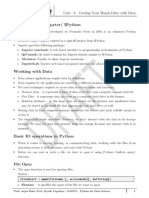0 ratings0% found this document useful (0 votes)
13 viewsPythonBasic Assignment13
Uploaded by
nikhilesh singhCopyright
© © All Rights Reserved
Available Formats
Download as PDF or read online on Scribd
0 ratings0% found this document useful (0 votes)
13 viewsPythonBasic Assignment13
Uploaded by
nikhilesh singhCopyright
© © All Rights Reserved
Available Formats
Download as PDF or read online on Scribd
You are on page 1/ 4
6110123, 9:25 PIM
In [11]
In [ ]:
Unitles-Jupyter Notebook
Assignment 13
1. What advantages do Excel spreadsheets have over CSV
spreadsheets? {|
The Advantages of Excel over CSV are:
1, Excel (XLS and XLSX) file formats are better for storing and analysing complex data,
2. An Excel not only stores data but can also do operations on the data using macros,
formulas ete
3. CSV files are plain-text files, Does not contain formatting, formulas, macros, etc. Itis also
known as flat files
2.What do you pass to csv.reader() and csv.writer() to create reader
and writer objects?
import csv
with open(‘usernane.csv','r') as file:
csv_file = csv.reader(file,delimiter=',')
for ele in csv_file:
print (ele)
['Name', ‘Branch’, 'Year', ‘CGPA']
Qa
['Nikhil', "COE",
Q
['Sanchit', *coe', '2", '9.1°]
Qa
['Ravi', ‘IT, 12", 19.37]
a
‘9,0']
3. What modes do File objects for reader and writer objects need to
be opened in?
For csv.reader(iterable_file_object), the file objects needed to be opened in read mode
mode="" Whereas for osv.writer(iterable_fle_object) the file objects needed to be opened in
write mode mode="w'
localhost 8888/notebooks/Documents/Untied ipynb?kernel_name=python’ M4
6110123, 9:25 PIM
In [10]:
lochs: 8888/notebooks/Documents/Untied ipynb Kern
Unitles-Jupyter Notebook
4, What method takes a list argument and writes it to a CSV file?
cesviwriter class provides two methods for writing to CSV. They are writerow() and writerows\).
writerow() method writes a single row at a time, Whereas writerows() method is used to write
multiple rows at a time.
# Example Program
import csv
fields = [‘Name', ‘Branch’, ‘Year’, 'CGPA'] #coLumn names
rows = [
['Nikhil', ‘COE, '2', '9.0'], # data rows of csv file
['Sanchit', ‘coe’, '2', "9.1°],
['Ravi', ‘IT, '2', 19.3°]
]
with open("username.csv", 'w') as csvfile:
csvwriter = csv.writer(csvfile) # creating a csv writer object
csvwriter.writerow(fields) # writing the fields
csvwriter.writerows(rows) # writing the data rows
5. What do the keyword arguments delimiter and line terminator do?
Lets take the example of a csv file
First Name, Branch, Year, CGPA
Nikhil, COE, 2, 9.0
Sanchit, COE, 2, 9.1
Ravi, IT, 2, 9.3
Here ',' is Delimiter. We can use any Character as per our needs if
required. Similarly Line Terminator comes at end of line by default it is
newline and can be changed accourding to Requirement.
6. What function takes a string of JSON data and returns a Python
data structure?
loads() method takes a string of JSON data and returns a Python data structure
26
6110123, 9:25 PIM
In [13]:
In [16]:
lochs: 8888/notebooks/Documents/Untied ipynb Kern
Unitles-Jupyter Notebook
# Example of json.Loads() method
import json
my_details_json ='''{
‘Mano Vishnu",
"Name
Bachelor of Technology",
Qualification”
‘Strean”: "Computer Science and Engineering”
ye
print(my_details_json)
print(f'Type of my_details_json is {type(my_details_json)}')
my_details = json.loads(my_details_json)
print(my_details)
print(f'Type of my_details is {type(my_details)}")
{
"Name": "Mano Vishnu",
"Qualification": "Bachelor of Technology",
“Stream”: "Computer Science and Engineering"
+
Type of my_details_json is
('Name': ‘Hano Vishnu’, ‘Qualification’: ‘Bachelor of Technology’, ‘Stream’:
‘Computer Science and Engineering’)
Type of my_details is
7. What function takes a Python data structure and returns a string
of JSON data?
dumps() method takes a python data structure and returns a string of JSON data
# Example of json.dumps() method
import json
t
my_details
"Name':'Nikhilesh Singh",
*stream': ‘Computer Science and Engineering’,
‘Qualification’: 'Bachelor of Technology’
+
print(my_details)
print(f'Type of my_details is {type(my_details)}')
my_details_json = json.dumps(my_details, indent=4, sort_keys-True)
print(my_details_json)
print(f'Type of my_details_json is {type(my_details_json)}')
('Name': 'Nikhilesh Singh", ‘Stream’: ‘Computer Science and Engineering’, ‘Qu
alification': ‘Bachelor of Technology’ }
Type of my_details is
{
“Nikhilesh Singh",
Qualification": “Bachelor of Technology",
Stream": "Computer Science and Engineering”
}
Type of my_details_json is
3
6110123, 9:25 PIM Unitles-Jupyter Notebook
lochs: 8888/notebooks/Documents/Untied ipynb Kern
|_name=python3 4
You might also like
- Python GTU Study Material E-Notes 3 16012021061619AMNo ratings yetPython GTU Study Material E-Notes 3 16012021061619AM36 pages
- PythonForDataScience Small00center10 10501605No ratings yetPythonForDataScience Small00center10 105016058 pages
- EMPLOYEE DATA ANALYSIS SYSTEM (IP CLASS XII)No ratings yetEMPLOYEE DATA ANALYSIS SYSTEM (IP CLASS XII)26 pages
- Week 1: 1 The Python Programming Language: FunctionsNo ratings yetWeek 1: 1 The Python Programming Language: Functions9 pages
- Notes For Fintech Assesment, CheatsheetNo ratings yetNotes For Fintech Assesment, Cheatsheet19 pages
- Employee Data Analysis System ( Ip Class 12 ) ( 2024-25 )No ratings yetEmployee Data Analysis System ( Ip Class 12 ) ( 2024-25 )30 pages
- KV No-3 Bhopal Shift-2_IP_ImportExport Between Csv and DataframeNo ratings yetKV No-3 Bhopal Shift-2_IP_ImportExport Between Csv and Dataframe18 pages
- Experiment No 3 Importing and Exporting Data in Python Using Pandas StudentNo ratings yetExperiment No 3 Importing and Exporting Data in Python Using Pandas Student6 pages
- Data Handling using Pandas - Revision NotesNo ratings yetData Handling using Pandas - Revision Notes6 pages
- Q1.What Is Dictionary Ans - Dictionaries in Python Is A Data Structure, Used ToNo ratings yetQ1.What Is Dictionary Ans - Dictionaries in Python Is A Data Structure, Used To23 pages





























































